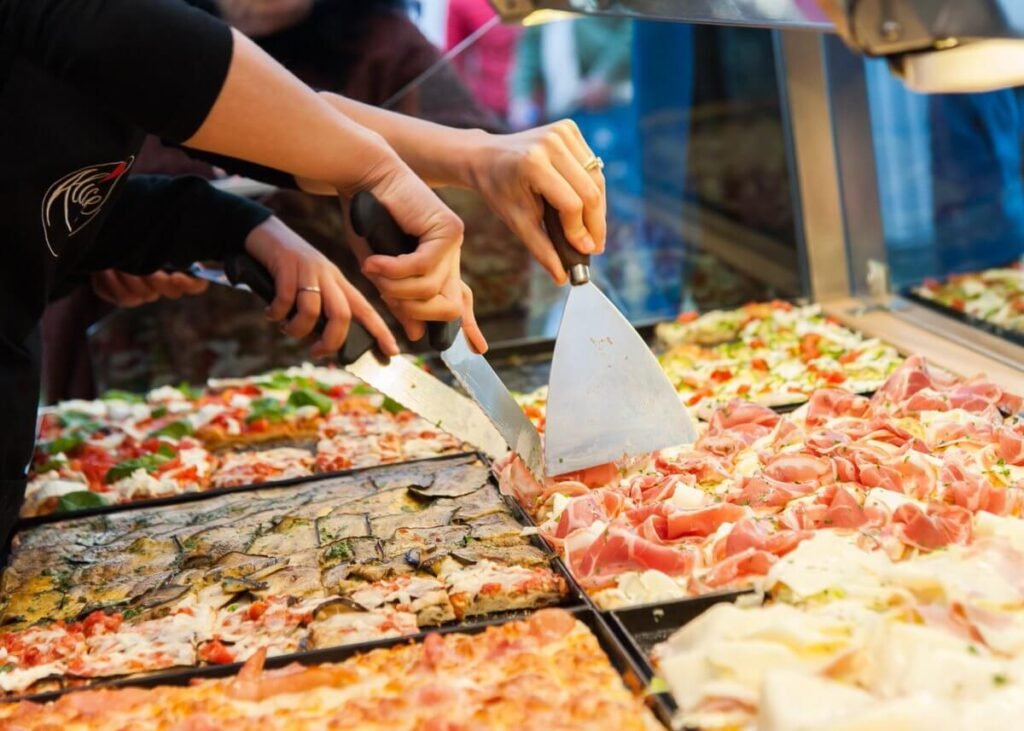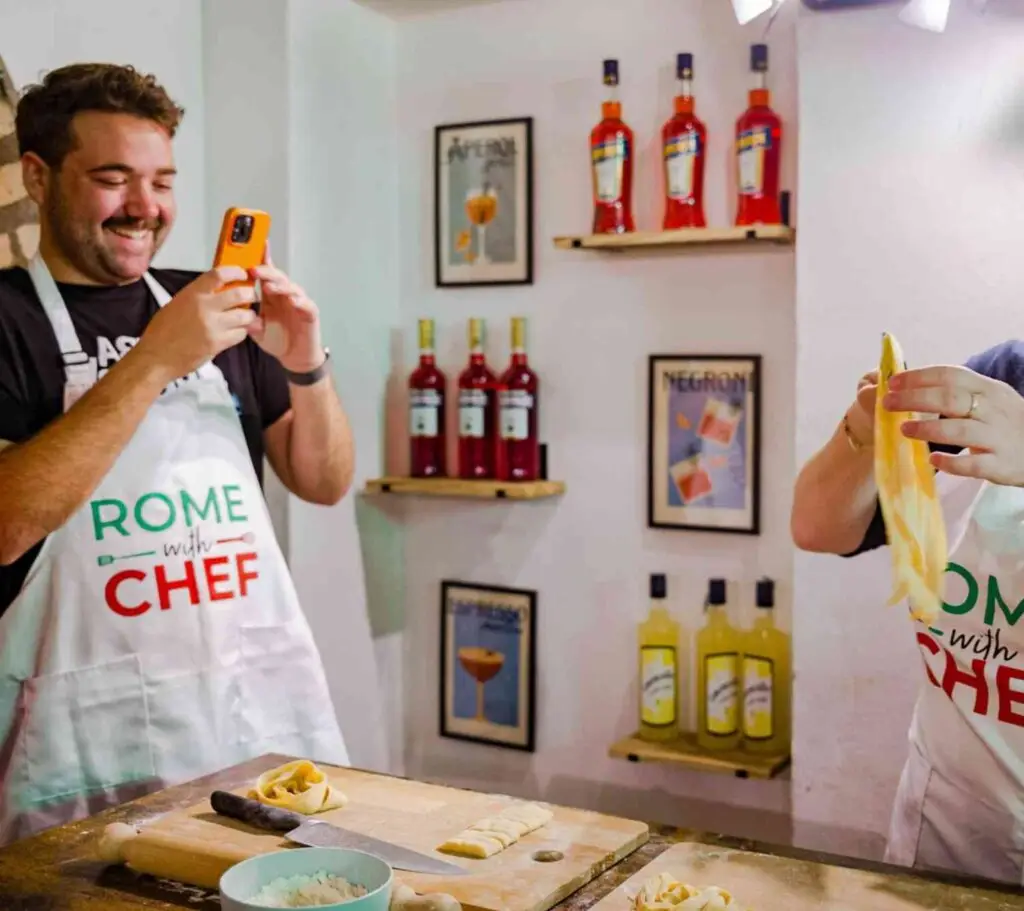Crisp rectangular crusts and simple freshly sourced ingredients cast Roman-style pizza in a league of its own. But despite originating in the Italian capital, Roman pizza is less well-known than its deep dish or Neapolitan counterparts. So what is Roman-style pizza? How does it differ from Neapolitan pizza? And where (in Rome) is the best place to try it?
What is Roman-Style Pizza?
Roman-style pizza (pizza romana) is famous for its thin, crunchy crust and rectangular shape, which is a stark contrast to the softer circular crusts found in other styles of Italian pizza.
Its dough is made from high-gluten flour, water, yeast, salt, and a drizzle of olive oil for maximum crispiness. This yields a thin, crunchy crust which does not proof while baked, meaning the resulting crispy, airy crust can support many toppings without becoming soggy.
Roman-style pizza also comes served by the slice (al taglio). One of the first things you’ll notice when visiting a Roman street food pizzeria is that you have to choose the size of your slice. Unlike the pizza places we’re used to, which serve a sort of circular pie, Roman pizzerias set out their freshly baked pizza on the counter, and cut slices using scissors, or sometimes a knife.
While this might seem intimidating (as it necessitates communication) it means you get to try a wider variety of Roman-style pizza!

The History of Roman-Style Pizza
Historically, the pizza that we know and love today originated around the 18th century. Our first mention of tomatoes on pizza dates back to the mid-18th century, when Vincenzo Corrado, a cook, philosopher and man of letters, wrote a treatise on the eating habits of Naples. He recounted how tomato sauce was used to season pizzas and macaroni pasta.
These were the years when pizza was the preserve of bakers, not pizza-makers (pizzaioli). It represented what we would today call ‘street food’, to be eaten immediately, folded up on itself.
La pizza margherita, today’s most famous pizza, was invented in Naples in 1889 for Queen Margherita of Italy. While visiting Naples with her husband Umberto I to open a train line, Margherita saw some peasants eating this strange food on the streets and she wanted to try it. And so its creator – the coolly named Raffaele Esposito – prepared her a tricolour pizza with tomato sauce, basil, and buffalo mozzarella, which captured the colours of the Italian flag.
Typical Pizza Toppings
Just three simple ingredients – pecorino cheese, pepper, and basil – topped the first Roman-style pizzas (the first two also form the basis of most Roman pasta dishes). But the best-loved pizza among today’s Romans is the Capricciosa, which includes toppings of mushrooms, prosciutto, artichokes, olives, and a sliced boiled egg.
The toppings for Roman-style pizza are typically simple but flavorful, often featuring fresh mozzarella, San Marzano tomatoes, basil, and a drizzle of extra virgin olive oil. The emphasis is on the quality of the ingredients rather than the quantity. Roman pizzas are usually cooked in an electric oven, which contributes to their characteristic texture and evenly cooked toppings.
Quick & Easy Roman-Style Pizza Recipe
Become king or queen of dinner parties with this Roman-style pizza recipe for four!
- Makes: 4 pizzas
- Prep time: 20 min
- Total time: 1 hr 45 min
- Cook time: 10 min
Ingredients
For the pizza dough
- 12 ounces (340 grams) lukewarm water
- 2 packages (about 14 grams) active dry yeast
- 2 tablespoons (30 ml) olive oil, plus more for surfaces
- 4 cups (500 grams) all-purpose flour, plus more for surfaces
- 2 teaspoons (10 grams) salt
To assemble
- 1 cup (240 ml) crushed or grated tomatoes or tomato sauce (for a tomato-based pie) or ½ cup (120 ml) olive oil (for a pizza bianca)
- 12 ounces (340 grams) fresh Buffalo mozzarella or ricotta cheese
- 1 cup assorted toppings such as pepperoni, sausage, prosciutto, arugula, shaved zucchini, artichokes, olives, or cherry tomatoes
Instructions
- Prepare the Dough: In a large bowl, dissolve the yeast in lukewarm water and let it sit until frothy, about 4–5 minutes. Add olive oil, then gradually mix in the flour and salt to form a shaggy dough. Knead on a lightly floured surface until smooth and elastic, approximately 5–6 minutes.
- Let the Dough Rise: Place the kneaded dough in a large, oiled bowl, turning once to coat it in oil. Cover with a damp cloth or plastic wrap and let it rise at room temperature until it doubles in size, roughly 1 hour and 15 minutes.
- Preheat and Prepare for Baking: Preheat the oven to 500 degrees Fahrenheit (260 degrees Celsius). Divide the risen dough into four equal parts, and on oiled or floured surfaces, stretch or roll each piece to fit your baking sheets.
- Assemble the Pizzas: Spread either tomato sauce or olive oil on each stretched dough, followed by evenly distributing the cheese and your choice of toppings.
- Bake the Pizzas: Place the pizzas in the preheated oven and bake for about 10 minutes, or until the cheese has melted and the crust is crisp and golden. Serve hot.
What is the Difference Between Roman Style Pizza and Neapolitan Pizza?
The dough is what defines a Roman or Neapolitan-style pizza. Extra-virgin olive oil keeps the dough of a Roman-style pizza much more supple, allowing the crust to be hand-stretched to its unique and characteristic thinness.
Because pizza is simple and uses relatively few ingredients, its taste is influenced by the quality of your ingredients. Rome’s best pizzerias use rustic flours that easily absorb water and stand up well to the long fermentation and rising time required (up to 48 hours in some cases).
Different cooking methods also distinguish Neapolitan and Roman-style pizzas. The former are typically cooked at extremely high temperatures (up to 900°F or 482°C) in a wood-fired oven for a short period (about 90 seconds), giving them a charred and blistered crust. Roman pizzas are instead baked at lower temperatures in electric ovens, resulting in a uniformly crispy texture.
Enjoy Rome’s Tastiest Pizza on our Trastevere Food Tour!
Experience the authentic taste of Roman-style pizza first-hand on our award-winning Food Tour of Trastevere. Your time in Rome is too precious to waste on overpriced, underwhelming food. By joining our tour, you’ll steer clear of the tourist traps, feed your curiosity, and satisfy your stomach as you taste at least 12 types of food and wine!
This fun, filling food tour gives you and a small group of others insider access to Rome’s best delicatessens, pizzerias, and restaurants as well as the tastiest traditional food the Romans keep to themselves. But don’t just take our word for it — see what others are saying!






